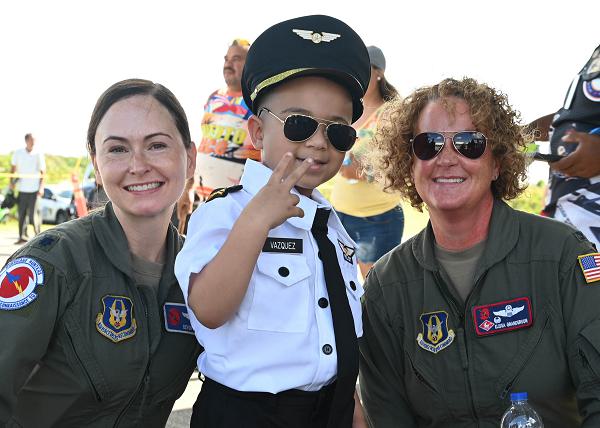
Aguadilla, Puerto Rico. (May 2, 2024): In this photo Lieutenant Colonel Marnee A.C. Losurdo, a future “Hurricane Hunter” flashes the victory sign at a youth Caribbean Hurricane Awareness Tour held here this week. Pictured are Colonel Elissa Granderson, 403rd Operations Group commander and pilot, and Lieutenant Colonel Devon Burton, 53rd Weather Reconnaissance Squadron pilot, both members of the Air Force Reserve’s Hurricane Hunters.
Working with hurricane specialists from the National Oceanic and Atmospheric Administration (NOAA), the Hurricane Hunters try to figure out whether or not a tropical system could turn into a hurricane. The teams keep a continuous watch on tropical cyclones and areas of disturbed weather within the North Atlantic and eastern North Pacific basins.
Once a system is spotted, NOAA issues analyses and forecast advisories on the system’s development, current strength, and likely movements. The agency also issues tropical storm and hurricane warnings for the U.S. and Caribbean territories.
The Hurricane Hunters fly state of the art C-130 cargo planes directly into these tropical storms to gather data that is critical to forecasting a hurricane’s intensity and possible landfall. The data are sent in real-time via satellite from the aircraft directly to the National Hurricane Center for analysis and use by hurricane forecasters. During each pass through the eye, crews release a dropsonde, which collects temperature, wind speed, wind direction, humidity, and barometric pressure data. The crew also collects surface wind speed and flight-level data.
When they are not flying through hurricanes, the 403rd Wing's 53rd Weather Reconnaissance Squadron promotes hurricane awareness and preparedness throughout the Caribbean region. This year, more than 13,000 people attended hurricane preparedness exhibits held in Nassau, Bahamas, Barbados, St. Lucia and Aguadilla, and Puerto Rico. Locals were able to tour the WC-130J aircraft and talk to NHC forecasters, Airmen with the 53rd Weather Reconnaissance Squadron, and a crew member with NOAA’s Aircraft Operations Center.
Hurricane season starts June 1 and ends Nov. 30th and an “extremely active” hurricane season is likely. According to forecasters at Colorado State University, there will be twenty-three named storms and eleven hurricanes, five of which are projected to be major hurricanes.


